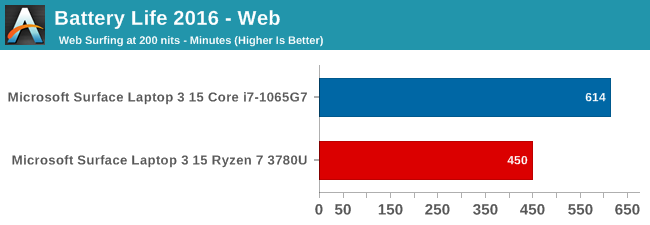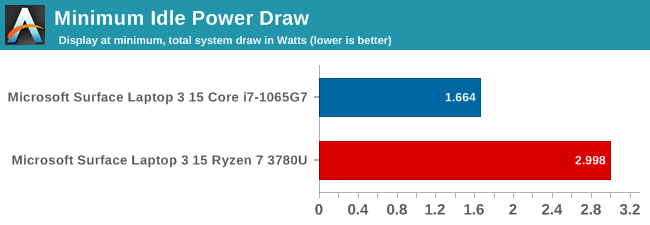The Microsoft Surface Laptop 3 Showdown: AMD's Ryzen Picasso vs. Intel's Ice Lake
by Brett Howse & Andrei Frumusanu on December 13, 2019 8:30 AM ESTPlatform Power
Performance aside, the other side of the coin is battery life. AMD made big gains in battery life with the Ryzen 3000 series, somewhat addressing the power requirements of the platform and getting rid of some of the excessive idle power draw, but they are still using DDR4 on their mobile platform, which puts them at a disadvantage right out of the gate. Intel has made very good gains in battery life over the last several generations, and the move to 10 nm for Ice Lake also brought along LPDDR4X support. Most of the previous generation laptops stuck with LPDDR3, unless the manufacturer needed more than 16 GB of RAM, where they’d be forced to switch to DDR4. Finally adding LPDDR4X support is something that Intel has needed to do for a while, and ironically Intel’s flagship Core product line lagged behind their low-cost Atom lineup which did support LPDDR4.
Web Battery Life

The Ryzen 7 3780U powered Surface Laptop 3 was slightly under the Ryzen 5 device we tested at launch, but still in the same range. The AMD system isn’t helped very much by Microsoft only offering a 46 Wh nominal battery capacity, which is rather undersized for a 15-inch laptop. The Ice Lake device, as we’ve seen before, was much more efficient under load, offering a sizeable battery life lead.
Idle Power
One of AMD’s biggest challenges was to get their laptop SoC into a premium device, and with the Surface Laptop 3 they have succeeded. Microsoft has shown themselves as being adept at squeezing battery life out of devices, with low-power displays, and good internal components to minimize power draw. Here Intel has held a considerable advantage over the last couple of years, and the move to 10 nm should, in theory, help as well.
To test the idle power draw of both systems, the battery discharge rate was monitored with the screens fixed in at 5.35 nits, to minimize the power draw of the display on the result. Normally we’d prefer to have the display completely off for this test, but Microsoft’s power plan on the Surface Laptop actively turns off the laptop when the display times out.

The Ice Lake system was able to go all the way down to right around 2 Watts of power draw – and sometimes slightly under – with as low as 1.7 Watts seen. We’ve seen under 1 Watt of draw on an 8th generation Core Y series processor, and around 1.5 Watts on the same generation U series, so considering the display is not completely off on the Surface Laptop, the 2-Watt draw is quite reasonable.
The Picasso system was not quite as efficient, drawing 3 Watts at idle. This is in-line with the results we’ve seen on other Picasso systems and explains the lower battery life results on the AMD system. AMD made big gains moving from Raven Ridge to Picasso, but I’m sure the team is looking forward to the 7 nm Zen 2 coming to their laptops, which we hope will address this further.










174 Comments
View All Comments
lmcd - Friday, December 13, 2019 - link
There was a window where Intel was still mostly shipping dual-core i5s while AMD shipped the 2500U and 2700U for around the same price. Made for an interesting situation where the AMD units were effectively light-weight desktop replacements, while the Intel units served as ultralights, all while theoretically serving the same market.Point being, there already was a moment where AMD laptop recommendations have made sense.
Also worth noting that Intel's H-series laptops would be a great place for AMD to compete. I'm still unconvinced AMD's core design scales down that well, and afaik Ryzen Mobile still uses the desktop process nodes? So this might be an area where Intel still has a manufacturing advantage -- midrange power consumption.
Teckk - Friday, December 13, 2019 - link
Yes. Need more wins with HP and Dell, something like XPS. Not happening till mobile Zen2 at the very least.nathanddrews - Friday, December 13, 2019 - link
Ice Lake + G7 is giving me flashbacks to the Pentium M/Yonah era buzz.strahinja78 - Friday, December 13, 2019 - link
yeah,...and that wouldn't be good for AMDGreenReaper - Friday, December 13, 2019 - link
They need Zen 2 out on mobile. It'd sort at least half of the performance issues. Better memory would help there, on power, and with graphics as well.MBarton - Monday, December 30, 2019 - link
Zen 2 mobile is a low priority when server and HPDT have much higher margins. AMD needs to offer something competitive when they can afford to, but their margins is key to their financial recovery. Semi-custom CPU's for consoles are low margin, but at least in that case the volumes are so high and they're gaining a potential advantage in gaming by pushing game developers to optimize for RDNA.nathanddrews - Friday, December 13, 2019 - link
But it would be good for the consumer to get some serious computing power with energy efficiency in the mobile space that has otherwise been stagnant for a while.HStewart - Saturday, December 14, 2019 - link
The current Lice likes are consider lower watt models and replacements for higher end IceLake are probably in early 2020 - likely 6 and 8 core models and higher end GPU's.Not intended as gaming CPU's
Korguz - Sunday, December 15, 2019 - link
" higher end IceLake are probably in early 2020 - likely 6 and 8 core models and higher end GPU's. " um yea ok Hstewart, and you have proof of this how ?? my guess. you dont and this is just more of your pro intel opinions.HStewart - Friday, December 20, 2019 - link
Well it just base on Intel road maps with 10nm - it might not be Ice Lake and could be next version. There is no difference in this than people saying wait for Zen 3. So do you expect that Intel will be always on 14nm and current processor will only be on 10nm. Intel has expected roadmaps on 7nm and even far less, I believe and it just a feeling that this battle with chip size will be over next year. Just remember what Intel did during the Pentum 4 days with Frequency wars especial with Intel came out with I series. Until the Zen came out Intel was really look like a monopoly but in reality it is not just AMD was doing so poorly But AMD did Intel a blessing, competition helps company from being lazy and ineffectiveBut I just and older profession who send technology from the early days including original IBM PC with Intel 8088 cpu.